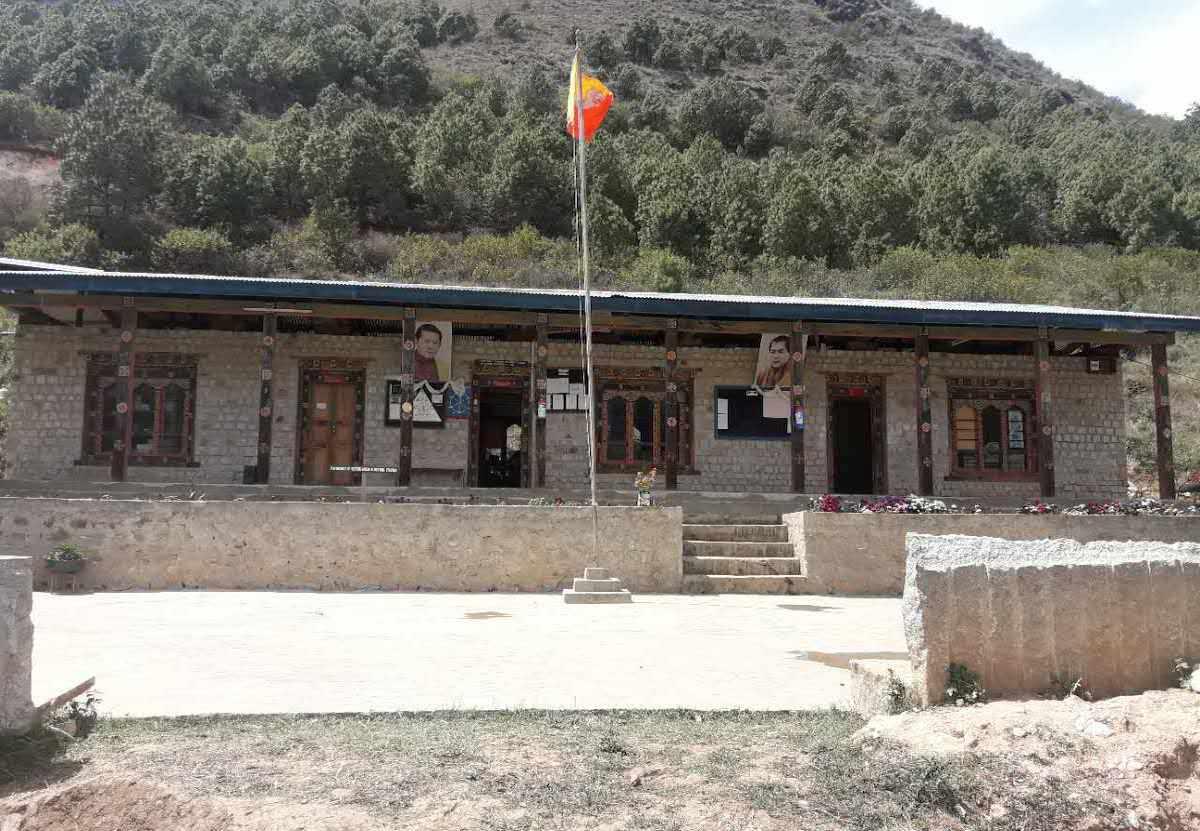Gewog Profile (Description):
Phangyuel Gewog is one of the smallest Gewog in the region. Phangyuel is made up of five Chewogs (Phangyuel-Koomchhi, Goenkha, Chungoen, Chungser-Domkha and Wampoekha). There are 210 gung holders in the Gewog. The total population, as per the Population and Housing Census of 2005 revealed that a total of 1,007 people inhabit in the Gewog, but as per the 2010 Census Phangyuel Gewog has 1,669 people registered, out of which 50.2% are male and 49.8% are female. As of now there are 1957 people registered in Phangyuel Gewog. Out of which Phangyuel Gewog consists of an estimated area of 32.70 sq km. The terrain consists mainly of gentle sloping areas, with an altitude ranging from 1200 to 3000 meters above the sea level. The areas under forest cover are 22.31 sq km i.e. 68.23% of forest coverage. The Gewog shares its boundary with the Limbukha Gewog of Punakha in the north, Kazhi in the north-east, Thetsho in the east and opposite to Nyisho, Bjena and Rubesa. Phangyuel Gewog has a cool sub-tropical to warm temperate type climate characterized by the moderately hot summers and moderately cool winters. The Gewog receives an average annual rainfall within the range of 500-1000 mm. The two most important monasteries in Phangyuel Gewog are Chungdu Goenpa above the Gewog centre and Dargye Goenpa in chungsaykha chewog. They serve as the important religious institution in the community. The Gewog also has small Lhakhangs like Chungsekha Lhakhang founded by Sha chungsay Ashi Goenzom in chungsaykha chewog, Phangyuel Goenpa Lhakhang at Phangyuel chewog and Goenkhar Kangtek Donkhor Lhakhang at katekha is being rebuilt recently. Chungse Lochok and Phangyul Bongko are the two most important festivals performed in the Gewog every after 3years. The Gewog also has one Dangrim chorten at Wampoekha and six Jangchub chortens. The Gewog centre is located at Katekha under Goenkha chewog with the beautiful scene and surrounded by chirpine trees. With the construction of 4.1 km farm road from Rakey Zampa to Goenkha, made the geog centre accessible to road network during dry season and raining seasons too. Phuensum Deki Community Pry School is the only school in the Gewog and it was established in 2004. At present it has seven teachers out of which one is a contract teachers and rest six teachers as regular. The schools also have a caretaker. There are around 91 students. In 2009, the school was upgraded to five standards and now it has sixth standard. As of now the school is developing the infrastructure for boarding facilities. Two hostels, one kitchen, toilets and a MPH is completed. Phangyuel Gewog agriculturally well known for rice, vegetables and fruit plants which grow by virtue of its location, soil and its climate condition. The Gewog basically grows little of everything but the main crops grown are paddy, wheat, sweet buckwheat as food crops. The main fruits grown in the Gewog are orange, persimmon, plums and guavas etc. The Gewog also grows variety of chilies, radish, green leafy vegetables and tomatoes. But the productivity of the agriculture was hindered by the water scarcity problems. Thus, most of the farmers are depending on the monsoon rain for their cultivation. As a result the Gewog administration is mainly focusing its plan budgets for the RWSS and irrigation channel project. Gewog had a plan for the construction of 34kms Baychu Yuwa to ease the water scarcity problem. However, the irrigation channel passing through Kashi Gewog, Phangyuel Gewog couldn’t obtain public clearance from Kashi Gewog. Health services in the Gewog is catered by Bajo BHU in addition to one outreach clinic (ORC) situated at Goenkha. In 2009-10 Gewog has completed construction of more ORC at Katekha and chungserkha. The former serves the two chewogs namely, Phangyuel-Koomchhi and Goenkha. Whereas later serves three villages namely chungserkha, Domkha & Wampoekha. The road network connects all the villages in Phangyuel Gewog except few scattered houses. Wangdue to Baylangdra provides as the main road and all the roads in this chewog are taken from there. More than 90% of the villages in Phangyuel Gewog have road connectivity.
|
Local Government |
||||||
|
Gewog Name: |
Phangyuel |
|||||
|
Geographical Location |
|
|||||
|
Total Area (sq.kms) |
32.70 sqkm |
|||||
|
Total No. of Chiwog |
Five(5) |
|||||
|
Community center |
|
|||||
|
Total Population |
Male |
Female |
Total |
|||
|
997 |
960 |
1957 |
||||
|
Total No. of Villages |
9 |
|||||
|
No. of Households |
210 |
|||||
|
Business License Holder |
08 |
|||||
|
Household with BBS and cable TV |
55 |
|||||
|
Agriculture |
||
|
RNR extension centers |
1 |
|
|
Farmer’s cooperatives |
0 |
|
|
Irrigation schemes |
Number |
KMS |
|
15 Channels |
52.5 |
|
|
No of Community forest |
3 Registered and 2 under process |
|
|
Total Forest Coverage |
63% |
|
|
Education |
|||||||||||
|
No. of Schools |
HSS |
MSS |
PS |
ECR |
NFE |
TOTAL |
|||||
|
|
|
1 |
|
|
|
||||||
|
No. of Students |
Boys |
Girls |
Boys |
Girls |
Boys |
Girls |
Boys |
Girls |
Male |
Female |
Total |
|
|
|
|
|
44 |
46 |
|
|
|
|
90 |
|
|
No. of Teachers |
M |
F |
M |
F |
M |
F |
M |
F |
M |
F |
Total |
|
|
|
|
|
4 |
3 |
|
|
|
|
7 |
|
|
Teacher student ratio |
1:12.75 |
||||||||||
|
Health |
|||||||
|
Hospital/BHUs/ORCs |
Hospital |
་ BHU |
ORC |
Total |
|||
|
|
|
2 |
|
||||
|
RWSS Coverage |
No. Household With RWSS coverage |
Percentage (%) |
No. of Household Withhout RWSS coverage |
Percentage (%) |
|||
|
0 |
100% |
0 |
100% |
||||
|
Electricity |
|||||
|
Household electrified |
No. |
% |
Household without Electrified |
No. |
% |
|
210 |
100% |
0 |
0 |
||
|
Tele-communication |
|
|
Village with Mobile network |
9 |
|
Village without mobile network |
0 |
|
Roads Networks |
|
|
GC Roads (KMS) |
7 KMs (Chuzomsa to Kateykha) |
|
Farm Roads (KMS) |
27.5 KMs (within the Gewog) |
|
Religion & Culture |
||||
|
Lhakhangs |
Govt. Owned |
Community |
Private |
Total |
|
1 |
2 |
|
3 |
|
|
Local Government |
||||
|
Village Name Population |
Village |
Male |
Female |
་ Total |
|
1. Phangyuel |
232 |
275 |
507 |
|
|
2. Kumchi |
54 |
49 |
103 |
|
|
3. Genkha |
162 |
172 |
334 |
|
|
4. Nabesa |
132 |
151 |
283 |
|
|
5. Rebekha |
||||
|
6. Bechumo |
||||
|
7. Chungsaykha |
199 |
187 |
386 |
|
|
8. Domkha |
87 |
82 |
169 |
|
|
9. Hampaykha |
81 |
94 |
175 |
|
Civil Infrastructure
|
Sl |
Name |
Year of const. |
Remarks/Issues |
||||||
|
1 |
Gewog Office |
2003 |
|
||||||
|
2 |
RNR |
2003 |
|
||||||
|
3 |
BHU/Hospitals/ORC |
2012 |
Both constructed in the same FY |
||||||
|
No. of Farm Roads |
|||||||||
|
Sl |
Name |
Length |
Const. Year |
Remarks |
|||||
|
1 |
GC road |
7 KMs |
2002 |
|
|||||
|
2 |
Phangyuel FR |
5 KMs |
2012 |
|
|||||
|
3 |
Pachey FR |
3.5 KMs |
2008 |
|
|||||
|
4 |
Chungoen FR |
3 KMs |
2012 |
|
|||||
|
5 |
Omlagang GR |
2 KMs |
2013 |
|
|||||
|
6 |
Chungsaykha FR |
3KMs |
2001 |
|
|||||
|
7 |
Rebakha FR |
1.5 |
2013 |
|
|||||
|
8 |
Domkha FR A |
1.5 KMs |
2013 |
|
|||||
|
9 |
Domkha FR |
1 KM |
2014 |
|
|||||
|
10 |
Hampaykha |
7 KMs |
2003 & 2013 |
Const. in two phase |
|||||
|
Livelihood |
|||||||||
|
Sl |
Name of the crop/livestock |
Annual Production |
Remarks/ Issues |
||||||
|
1 |
Paddy |
346352 KGs |
|
||||||
|
2 |
Wheat |
70590 KGs |
|
||||||
|
3 |
Vegetables |
13267 KGs |
|
||||||
|
4 |
Oranges |
13045 KGs |
|
||||||
|
5 |
Milk |
806000 Ltrs |
|
||||||
|
6 |
Butter |
45000 KGs |
|
||||||
|
7 |
Cheese |
75000 KGs |
|
||||||
Cultural monuments
|
Sl |
Name of Lhakhang |
Description |
|
1 |
Phangyuel Lhakhang |
Believed to be the “Densa” of Lam Drukpa Kuenley. Before the lam of the Lhakhang is sent from Tibet. |
|
2 |
Chundu Goenpa |
“Densa” of “Drubthob” Thinley Pema. The main “Nangten” is Guru and its “Sung Joen”. The local deity is ‘Thinley Zam”. |
|
3 |
Dagay Goenpa |
“Densa” of Lam Drukpa Kuenlay. It is said that the first Buddhism was spread from there so; it came to known as “Dagay”. The local deity is “Lu Sum” means three regions. |


